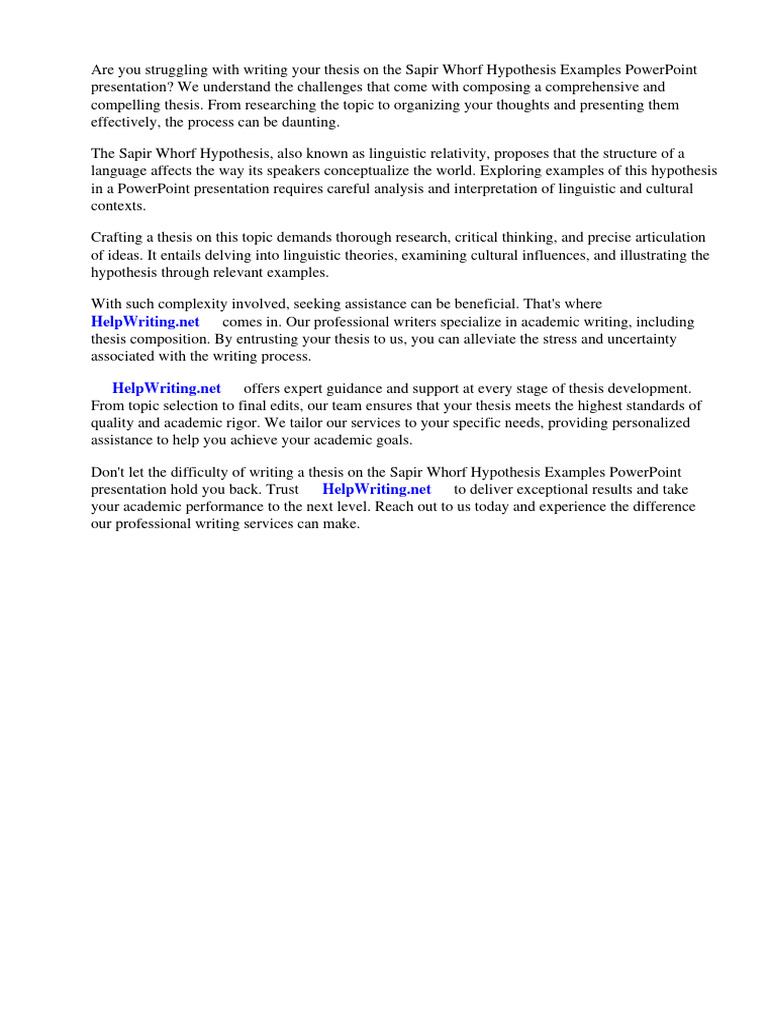The Sapir-Whorf Hypothesis, a cornerstone in linguistic anthropology, posits that the language one speaks influences not only thought processes but also the perception of the world. This concept, often encapsulated in its most famous aphorism, suggests that language and culture are inextricably linked, leading to variations in interpretation among different linguistic communities. To exemplify this theory within the realm of sociology, we will explore several instances that intricately demonstrate how language shapes social reality.
Firstly, consider the division of a natural phenomenon as simple as color. In the English language, we possess a robust palette: red, blue, yellow, and their myriad shades. However, in the Himba tribe of Namibia, their lexicon omits certain basic color distinctions found in English. They categorize colors differently, primarily focusing on shades and the relationships between them. The implications of such linguistic framing extend beyond mere aesthetic appreciation; they resonate through the lens of identity and social structure. For the Himba, colors are entwined with their social fabric, reflecting their environmental interactions and ecological awareness. Thus, language shapes not only how individuals perceive colors but also how they relate to their surroundings and each other.
Transitioning to the social structure, we observe how the linguistic schema of kinship terms in various cultures informs familial hierarchies and societal norms. In certain Indigenous languages, such as those spoken by various Native American tribes, there exists a rich tapestry of kinship terminology that delineates relationships more precisely than the English words “father” or “mother.” For instance, in the Inupiat language, terms like “ikiaq” (an uncle from the mother’s side) carry not merely a biological connection but a set of cultural expectations and responsibilities. This multidimensional approach to familial ties underlines how language encapsulates social norms, expectations, and the very essence of community, reinforcing bonds that are pivotal to cultural sustainability.
Furthermore, consider how language can influence conceptions of time and space, profoundly affecting societal organization and daily life. The Hopi tribe, renowned for its unique approach to time, employs a linguistic framework that emphasizes the present rather than a linear past or future. Their language lacks conventional tenses, focusing instead on ongoing processes. This perspective engenders a worldview deeply rooted in the present moment, fostering a societal emphasis on immediacy and experiential living. In contrast, cultures steeped in chronometric languages, such as English, tend to prioritize planning and scheduling, leading to a more future-oriented mindset. The dichotomy here lays bare the underlying influence of linguistic structures on sociocultural dynamics and individual perceptions of existence.
Moreover, gendered language provides another evocative example of the Sapir-Whorf Hypothesis in sociology. In many languages, including Spanish and French, nouns possess gender classifications. This linguistic characteristic not only manifests in grammatical form but also permeates social expectations and gender norms. Research demonstrates that individuals who speak gendered languages often exhibit heightened consciousness of gender in their social interactions, reinforcing traditional gender roles and stereotypes. In contrast, languages that adopt a more neutral stance, such as Chinese, may engender a less stratified perception of gender norms, resulting in more fluid social identities. Such linguistic nuances elucidate how language can act as a conduit for societal expectations regarding identity, reinforcing or challenging normative frameworks.
The impact of language on collective memory further illustrates the intricate interplay between linguistics and sociology. In many Polynesian cultures, the use of oral traditions serves as a vehicle for preserving history and communal identity. The magnificently complex narratives woven into their storytelling carry cultural significance, ensuring the transmission of values, beliefs, and lessons across generations. The choice of words, metaphors, and narrative structures reflects a collective understanding of the world, anchoring individuals within their cultural contexts. Language, therefore, is not merely a means of communication but a vessel for shared identities and communal bonds.
Additionally, the phenomenon of euphemism offers an arresting lens through which to examine the Sapir-Whorf Hypothesis. Euphemisms mask uncomfortable realities, serving both to soften the impact of a message and to shape social discourse. Consider how the language of war may be couched in terms like “collateral damage” or “pre-emptive strike.” Such terminologies recalibrate moral judgments and affect public perception, steering societal dialogue around contentious issues. The potency of euphemism demonstrates how linguistic choices can frame ideologies, ensuring dominant narratives align with societal values and perceptions, often at the expense of clarity and honesty.
In sum, the Sapir-Whorf Hypothesis offers a fascinating prism through which to discern the correlations between language, thought, and societal dynamics. Through an examination of color perception, kinship terminology, conceptions of time, gendered language, collective memory, and euphemism, one can appreciate the profound influence of linguistic structure on social life. The words we choose are not mere signs; they are constructs that shape reality, molding our understanding of the world and our interactions within it. Each example vividly underscores the unique appeal of this hypothesis—language, in all its manifestations, serves as both a mirror reflecting society and a mechanism for societal change, unveiling the intricate tapestry of human experience.
